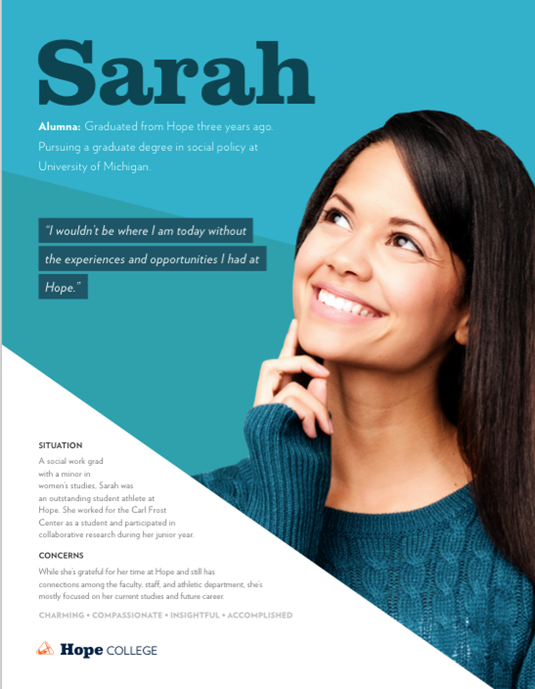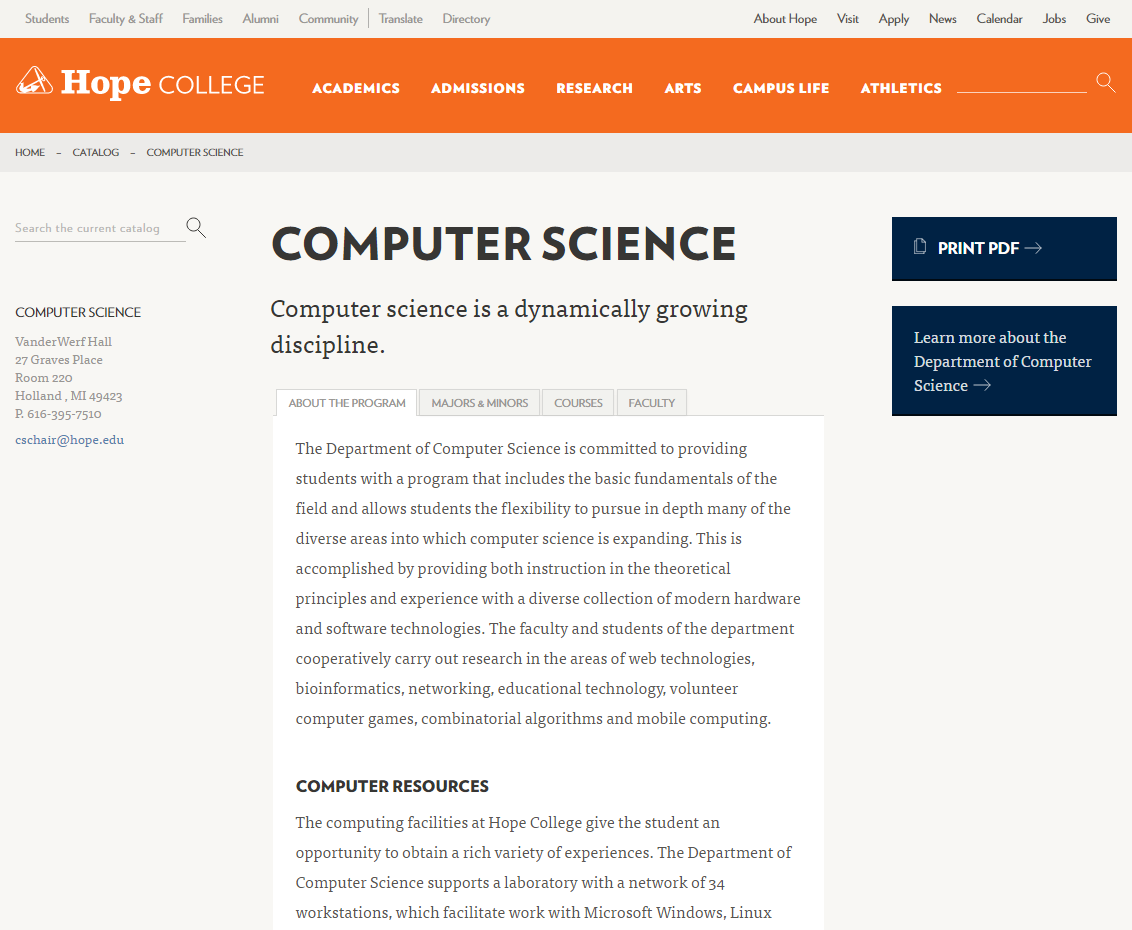SIDEBAR
About Hope College
Hope College is a private liberal arts school nestled in the heart of downtown Holland, Michigan. Founded in 1866 and historically affiliated with the Reformed Church of America, Hope College began with only ten students. Today, it is home to more than 3,300 students and offers more than 90 majors, minors, and pre-professional programs.
END SIDEBAR
With the majority of its website having been designed and developed over a decade ago, Hope College knew a website redesign was long overdue. The college web team re-launched several parts of the website in 2011 and 2012 as an interim solution, but a complete overhaul—not just a new look and feel—was imperative to effectively tell the Hope College story. The comprehensive redesign process began in 2013 and focused on several elements, including the revision of content to better address their audience and implementing new processes that clarified roles and workflows throughout the organization. All of the elements aligned with one underlying goal: to change the way Hope College communicated online.
Leaving Drupal Behind
Prior to the comprehensive redesign, the Hope College website was managed using Drupal. Despite being one of the largest open source projects in the world, Hope College experienced constant frustration and limitations with the content management platform. From a development standpoint, Drupal required a lot of time to manage and make changes to the system, which required resources the web team at Hope College simply did not have. Every new Drupal release would include API changes and new features that were incompatible with previous versions. As a result, each time the Hope College team updated their system, they ran the risk of breaking functionality that they had worked hard to maintain. This forced them to stop updating Drupal altogether.
Drupal's lack of support was another significant drawback for the Hope College web team. Whenever they had questions about their specific implementation of Drupal or adding a new feature to their site, there was no dedicated person or team to which they could turn. The web team wanted a partner they could count on when they had questions, both big and small. Craig Tommola, Web Developer and Designer at Hope College, stated, "Using open source solutions is difficult in higher ed because there’s limited resources to develop content and functions that you’re seeking. You have to maintain a system that you didn't create and you don’t have support for."
CTA = WHITE PAPER Uncover the four most common reasons college and university web teams gravitate toward open source products and get cautionary information about those arguments to help you make an educated decision for your own institution.
Building a Foundation for Change
When the idea of redesigning their website came about, the Hope College web team knew Drupal was not the system to support the new site. Selecting an enterprise-level content management system (CMS) was a top priority and the Hope College team made the conscious decision to choose a CMS before selecting a website design and development partner. To properly plan for a new system, the team developed a comprehensive website assessment, which led to them choosing Modern Campus CMS from Modern Campus. With a new CMS selected, they were ready to take on an overhaul of their site. They underwent another evaluation process and ultimately chose Mighty in the Midwest as their design and development firm. The firm's creativeness and ability to push the boundaries of development was the clincher for Hope College.
User Personas Lead the Way
The website redesign project began in early fall of 2013 with research and identification, which was comprised of a content inventory, reviewing analytics, and reevaluating their existing design. However, the most valuable feedback came from conducting a series of stakeholder interviews, where they talked with 150 people face-to-face from 23 different focus groups and forums. The Hope College web team then used the information gathered to create user personas, or fictitious people based on real-life needs and scenarios. There were 15 user personas created in total, including prospective students, faculty, alumni, and community members. Taking the project a step further, the web team organized a “Meet the Personas” open house, where the entire campus community was invited to learn more about each persona and the project as a whole. This concept would become the foundation for Hope College’s vision and would continue to play a crucial role in the remainder of their site’s implementation.

Hope College created 15 user personas for the website, including prospective students, faculty, alumni, and community members.
Enhancing the User Experience
Hope College wanted to carry out its new vision beyond just the website. The college had been offering a paper and PDF option of the college’s course catalog, which resulted in high printing costs and a poor user experience, as students had difficulty navigating through hundreds of PDF pages on the web. The Modern Campus online course catalog solution allowed them to integrate the catalog with the college's existing Banner® student information system, so they could pull course descriptions and faculty listings. With a new online solution in place, Hope College could automatically generate PDFs for each section of the catalog and provide users with the best of both worlds (web and PDF versions) without having to maintain them separately.

The Modern Campus online course catalog allows Hope College to integrate the catalog with their Banner® student information system, so they can pull course descriptions and faculty listings.
In addition to implementing a new online course catalog, the Hope College web team saw the opportunity to simplify their online directories. Modern Campus offered an online directory solution that also integrated with the college’s Banner system. By implementing the solution, the web team had the power to easily manage their four existing directories (Departments & Programs, Offices & Services, Buildings & Facilities, and People) from a single place and effectively enable users to search across all of the directories at once.
As the redesign began taking shape, the Hope College team also decided it was time to implement a new search solution that would better serve the needs of their site visitors. For a number of years, Hope College used Google Site Search, which was limited in various elements of its design. After exploring several options to replace Google’s solution, the team found Modern Campus' search to be the best fit. The Modern Campus module allowed Hope College to gain complete control of the look and feel of the search experience and results pages. It also gave Hope College the ability to elevate certain pieces of content based on search parameters and customize the search experience for site visitors.
Fulfilling Their Vision
By implementing Modern Campus CMS, the Hope College web team was able to focus more on the needs of their website visitors and less on resolving technical issues with their CMS. Modern Campus CMS’ open API and gadgets allowed the web team to further enhance the CMS by adding functionality on their own. Jason Cash, Director of Web Communications at Hope College, stated, "We chose the Modern Campus CMS system because it was super flexible. It allows us to do a lot of different things within the system and to really push the boundaries of what a CMS can do."
PULLQUOTE
"We chose the Modern Campus CMS system because it was super flexible. It allows us to do a lot of different things within the system and to really push the boundaries of what a CMS can do."
Jason Cash, Director of Web Communications
END PULLQUOTE
Hope College publicly launched "phase one" of the overhauled site in August 2015 using Modern Campus CMS and work will continue throughout 2016 until the entire site is completely redesigned and managed in the CMS. The website is fully responsive with social integration and a news section that creatively pulls into one place the many ways Hope College is telling its story. Josh Bishop, Web Content Manager at Hope College, explained, "There’s lots of magic working unnoticed behind the curtain, too. [The website] looks pretty, sure, but some of our favorite parts are the things we hope you’ll never notice."